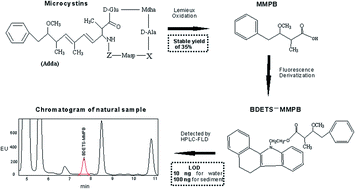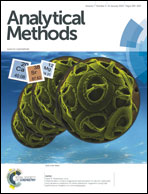A sensitive method for the determination of total microcystins in water and sediment samples by liquid chromatography with fluorescence detection†
Abstract
Microcystins (MCs) are potent hepatotoxins that comprise a family of more than 90 different variants. MCs can bind to matrices, after which they cannot be completely extracted by the solvent. Currently, the MMPB (2-methyl-3-methoxy-4-phenylbutyric acid) method is the only effective way of determining total MCs without solvent extraction. In this study, a sensitive method to determine the total MCs in water and sediment was developed based on the MMPB method. Specifically, MCs were oxidized to MMPB with an improved oxidation reagent (20 mg mL−1 NaIO4, 4000 mg L−1 KMnO4, pH ∼ 9) and a stable MMPB yield of about 35% was obtained for both water and sediment samples. The minimum volume of the oxidation reagent could be determined by the organic content in the matrix. After being concentrated, the MMPB was derivatized with 1,2-benzo-3,4-dihydrocarbazole-9-ethyl-p-toluenesulfonate (BDETS) and detected by liquid chromatography using a fluorescence detector. Quantification limits of MCs in water and sediment samples were 125 ng L−1 and 100 ng g−1 respectively. The method was successfully applied to Lake Dianchi and the soluble MC concentrations determined by this method were correlated well with those obtained by the enzyme-linked immunosorbent assay (ELISA).


 Please wait while we load your content...
Please wait while we load your content...